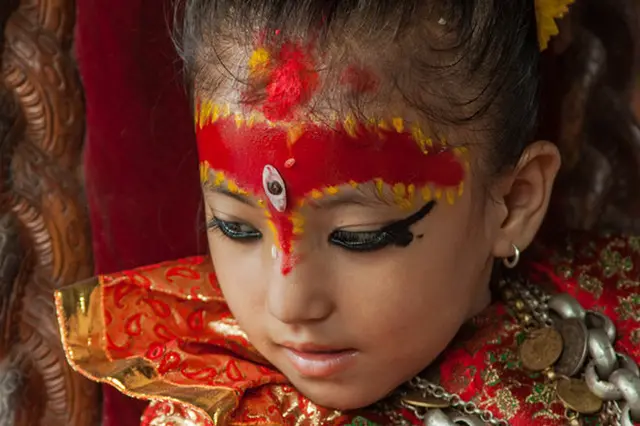Seven-year-old Smriti Bajrcharya and her parents' happiness knew no bounds when she was chosen as the living goddess "Kumari" of Bungmati in mid-May of 2014 amid the selection of long rituals and celebrations.
Since then, she has no longer lived a normal life as a regular child, but rather has been dressed in a special red long gown, unique hair-do and a makeup, including long black eye-liner all the time. She became a center of divine energy, respect and attraction.
On April 25, when the massive earthquake shattered Nepal, Bajracharya was sitting on her ceremonial altar. But, she didn't show any signs of terror in eyes or panic on her face; rather she sat in a calm manner as Kumaris, the incarnation of the Goddess Taleju Bhawani, are regarded as fearless.
Thanks to the centuries-long unique tradition of "Kumari" in culturally-rich Nepal, a young pre-pubescent girl is taken as a manifestation of divine energy and treated as sacred by everyone and worshipped as a Goddess.
But her golden days are going to end soon. On the fourth day of the great disaster, she lost one of her upper teeth while playing with friends, restricting her to continue as Kumari for a longer period.
Shantikar Bajracharya, a handicraft worker and father of Bungmati Kumari told Xinhua on Wednesday, "I feel sad that she lost her tooth so she cannot be Kumari anymore. There will be some rituals after the post-quake situation calms down and a new Kumari will be chosen."
There is a tradition that a Kumari will no longer remain a Kumari if she witnesses menstruation, illness or if heavy blood is released from any sort of injury from her body. In the case of Bungmati Kumari, she cannot be in the godly position owing to her lost tooth.
According to the religious belief of family members, the serene Kumari lost her tooth due to the earthquake."We went to our religious priest 'Maa' after the tooth fell fearing bad-luck. She said the Goddess Taleju is not leaving my daughter's body on her own. Only a tooth has been lost and it's due to the earthquake", Kumari's mother Sajita Bajracharya told Xinhua.
Bugnmati Kumari is regarded as very powerful compared to others, as she has the power to cure diseases.
There are mainly three prominent Kumaris in Nepal from Kathmandu, Patan and Bhaktapur and then comes Bungmati Kumari. Either at religious functions or the beginning of good works, her participation is utmost and significant.
Bungmati Kumari holds a special place in the process of pulling the chariot of Machhindranath, a festival of the Newar community observed every 12 years.
The festival began on April 22 this year, but has been halted owing to the earthquake.
Though prominent Kumaris live inside a palace called "Kumari Ghar" and study within the four walls of the same building, Bungmati Kumari lives in her own ordinary home, which has since been destroyed by the quake.
She goes to school but in her own attire and makeup. On Wednesday morning, Xinhua reporters spotted her doing mathematics homework with friends including the former Kumari near their make- shift home.
Kumari Smriti Bajrcharya told Xinhua, "I don't like to study much. I love to act in dramas and play games like hide and seek and skipping the most."
Though the tradition of Kumari commenced from around the 16th century, Bungmati Kumari doesn't receive any state facilities or allowances. Her living and education costs rest entirely upon the shoulders of the family members.
Former Bungmati Kumari Sophiya Bajracharya served as Kumari for the longest period of nine years. These days, she is living a normal life and studying in second grade.
Kamal Raj Bajracharya, Priest of the destroyed Machhindranath temple located in the center of Bungmati told Xinhua, "Smriti could serve as a Goddess for a very short period. Soon, we will have a new Kumari from another family from the Banodatt Bajracharya clan. This is our tradition, we must follow."
Smriti Bajrcharya will be replaced by a virgin girl as the new Kumari, after organizing a big feast for the entire village of Bungmati.
However, this seven-year-old, innocent, grade two student knows only a little about her upcoming change. She hesitantly smiled and pointing towards her friend's school dress told Xinhua, "I love to wear both red gowns and my school uniform including a skirt and a tie."
 简体中文
简体中文

